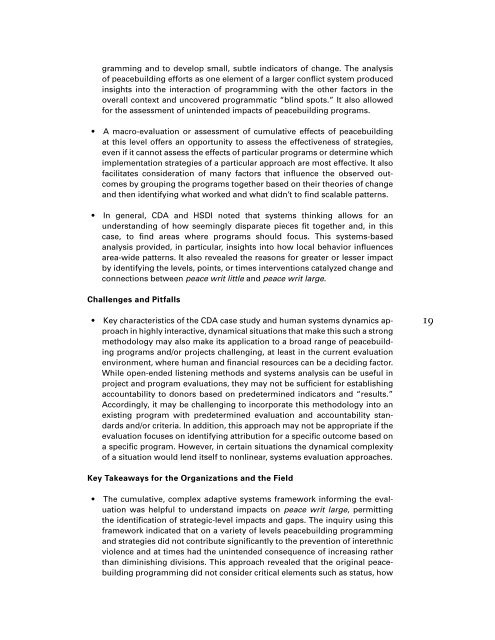Learning from Nine Examples of Peacebuilding Evaluation
Learning from Nine Examples of Peacebuilding Evaluation
Learning from Nine Examples of Peacebuilding Evaluation
You also want an ePaper? Increase the reach of your titles
YUMPU automatically turns print PDFs into web optimized ePapers that Google loves.
gramming and to develop small, subtle indicators <strong>of</strong> change. The analysis<br />
<strong>of</strong> peacebuilding efforts as one element <strong>of</strong> a larger conflict system produced<br />
insights into the interaction <strong>of</strong> programming with the other factors in the<br />
overall context and uncovered programmatic “blind spots.” It also allowed<br />
for the assessment <strong>of</strong> unintended impacts <strong>of</strong> peacebuilding programs.<br />
• A macro-evaluation or assessment <strong>of</strong> cumulative effects <strong>of</strong> peacebuilding<br />
at this level <strong>of</strong>fers an opportunity to assess the effectiveness <strong>of</strong> strategies,<br />
even if it cannot assess the effects <strong>of</strong> particular programs or determine which<br />
implementation strategies <strong>of</strong> a particular approach are most effective. It also<br />
facilitates consideration <strong>of</strong> many factors that influence the observed outcomes<br />
by grouping the programs together based on their theories <strong>of</strong> change<br />
and then identifying what worked and what didn’t to find scalable patterns.<br />
• In general, CDA and HSDI noted that systems thinking allows for an<br />
understanding <strong>of</strong> how seemingly disparate pieces fit together and, in this<br />
case, to find areas where programs should focus. This systems-based<br />
analysis provided, in particular, insights into how local behavior influences<br />
area-wide patterns. It also revealed the reasons for greater or lesser impact<br />
by identifying the levels, points, or times interventions catalyzed change and<br />
connections between peace writ little and peace writ large.<br />
Challenges and Pitfalls<br />
• Key characteristics <strong>of</strong> the CDA case study and human systems dynamics approach<br />
in highly interactive, dynamical situations that make this such a strong<br />
methodology may also make its application to a broad range <strong>of</strong> peacebuilding<br />
programs and/or projects challenging, at least in the current evaluation<br />
environment, where human and financial resources can be a deciding factor.<br />
While open-ended listening methods and systems analysis can be useful in<br />
project and program evaluations, they may not be sufficient for establishing<br />
accountability to donors based on predetermined indicators and “results.”<br />
Accordingly, it may be challenging to incorporate this methodology into an<br />
existing program with predetermined evaluation and accountability standards<br />
and/or criteria. In addition, this approach may not be appropriate if the<br />
evaluation focuses on identifying attribution for a specific outcome based on<br />
a specific program. However, in certain situations the dynamical complexity<br />
<strong>of</strong> a situation would lend itself to nonlinear, systems evaluation approaches.<br />
19<br />
Key Takeaways for the Organizations and the Field<br />
• The cumulative, complex adaptive systems framework informing the evaluation<br />
was helpful to understand impacts on peace writ large, permitting<br />
the identification <strong>of</strong> strategic-level impacts and gaps. The inquiry using this<br />
framework indicated that on a variety <strong>of</strong> levels peacebuilding programming<br />
and strategies did not contribute significantly to the prevention <strong>of</strong> interethnic<br />
violence and at times had the unintended consequence <strong>of</strong> increasing rather<br />
than diminishing divisions. This approach revealed that the original peacebuilding<br />
programming did not consider critical elements such as status, how














